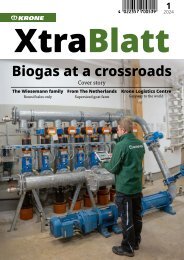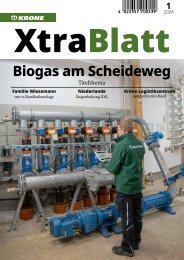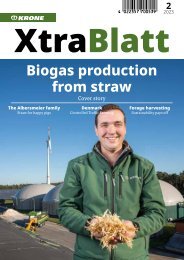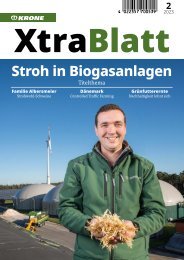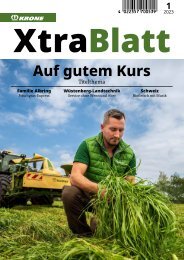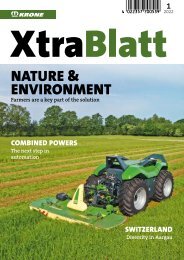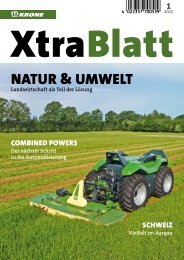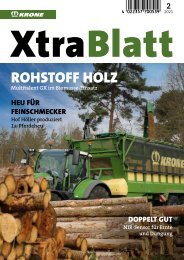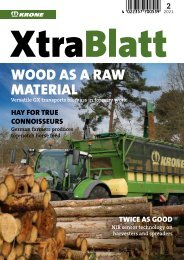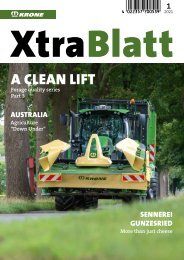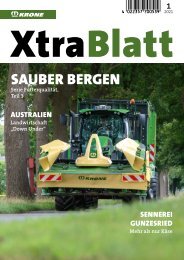XtraBlatt Issue 01-2023
Create successful ePaper yourself
Turn your PDF publications into a flip-book with our unique Google optimized e-Paper software.
The farm<br />
The Lambrecht-Speller Farm dates back to around<br />
1650. At that time, three men – named after their<br />
occupations – were commissioned to survey and<br />
map land in Breischen, an area in North Rhine<br />
Westphalia near the border with Lower Saxony.<br />
Der Dräger, der Speller und der Teeken wurden mit<br />
dieser Aufgabe vertraut. The Speller’s task was to<br />
operate the surveying instrument, which was called a<br />
Spiel – hence the name Speller. In payment for their<br />
work, the three men were each given a plot of land<br />
in Breischen, where the farms are situated. The farm<br />
has gone by the name of Spellerhof ever since, and<br />
the name Speller has passed down the generations as<br />
a suffix to the family name.<br />
Benedikt, Heinrich<br />
and Alexander<br />
Lambrecht-Speller<br />
(from left): Heinrich<br />
and Alexander run<br />
the family farm, while<br />
Benedikt works in<br />
Product Marketing at<br />
Krone.<br />
Our animals have<br />
access to fresh feed 24/7.<br />
Alexander Lambrecht-Speller<br />
The biogas<br />
plant is an<br />
effective<br />
means of<br />
utilising the<br />
manure.<br />
Heinrich<br />
Lambrecht-Speller<br />
A self-propelled feed mixer is used to ensure that<br />
the feed meets the animals’ requirements. The<br />
bulls are sold to an abattoir at 18 months with a live<br />
weight of approx. 800kg. The slaughter weight is<br />
at least half the live weight.<br />
Harvesting and machinery<br />
Most of the forage is produced in-house, with<br />
only brewer’s grains, rapeseed meal and pressed<br />
sugar beet pulp bought in. “On our 120ha farm we<br />
have 14ha of grassland and the rest is arable. The<br />
soil index score of our land ranges from 18 to 34,”<br />
tells Alexander Lambrecht-Speller. The land is<br />
managed in partnership with the neighbouring<br />
farm. “We do all the work ourselves except the<br />
harvesting, because we can hire the professional-level<br />
machinery,” he explains. So, they hire a<br />
contractor for harvesting, who mainly uses Krone<br />
machines. According to the farmers, the BiG X 630<br />
forage harvester is the cornerstone – it is its high<br />
chopping quality that is largely responsible for the<br />
high feed conversion rates and hence the farm’s<br />
success.<br />
“We currently use a Comprima V180 XC and have<br />
already tested a VariPack Plus. This produces an<br />
enormous bale weight, which makes the machine<br />
an intriguing proposition for us, because we do a<br />
lot of bale transportation and handling,” says Alexander.<br />
The straw harvest is particularly important<br />
for the farm as they need around 2,000 bales per<br />
year, which equates to around five bales per day.<br />
A trailed straw blower spreads fresh straw in the<br />
cattle’s resting area every day.<br />
How the manure is used<br />
The pens are mucked out once a week. “We use<br />
a “sloping floor” system here that originated in<br />
southern Germany. The resting areas inside the<br />
sheds have a slope of 5%; over time the cattle trample<br />
down the manure and litter, working it with<br />
their feet down to the manure passage. We collect<br />
it and take it to a digester,” explains Heiner Lambrecht-Speller,<br />
who also happens to be director of<br />
a local community biogas plant. “The biogas plant<br />
is an effective way of utilising the manure. This still<br />
contains plenty of energy because the cattle don’t<br />
digest the feed to 100%,” he adds. The digestate<br />
is then recovered and spread onto their fields as<br />
fertiliser – mainly using rented machines. But<br />
when the Lambrecht-Speller family need special<br />
services such as applying slurry with an injector,<br />
they turn to the local contractor.<br />
successful beef finishing. “Our animals have access<br />
to fresh feed 24/7. Currently, we are pushing up the<br />
feed in the feed passage several times a day. The pH<br />
value of the rumen fluctuates if insufficient premium<br />
quality feed is not provided at all times. This<br />
leads to rumen acidosis (excess acid production),<br />
which in turn has a negative effect on health and<br />
performance,” explains Alexander. For this reason,<br />
the farm is now investing in a Wasserbauer robotic<br />
feed pusher, which refills the feed passage ten to<br />
twelve times a day.<br />
“We hope that this year will not be as dry as last.<br />
The drought had a severe impact on the forage<br />
quality. We are trying to reduce the risk of a poor<br />
maize harvest by growing grass leys. However, the<br />
large number of cattle farms and the rising trend<br />
for potato growing in the region means that land is<br />
in short supply,” explains Alexander. Nevertheless,<br />
the farm managers are positive about the future:<br />
their next project is to build a new silage clamp to<br />
further improve the quality of their forage. «<br />
The trailed straw<br />
blower spreads five<br />
round bales in the<br />
sheds every day.<br />
The old pig shed<br />
was converted<br />
into a calf<br />
shed<br />
Future investment<br />
“In my view, light, air and water are fundamental<br />
to good cattle husbandry. So, as well as opting for<br />
an open and well-ventilated cattle house, we have a<br />
water system that cannot freeze,” says dad Heiner.<br />
Of course, an adequate supply of feed is also key to<br />
20 1|<strong>2023</strong> <strong>XtraBlatt</strong><br />
<strong>XtraBlatt</strong> 1|<strong>2023</strong><br />
21



